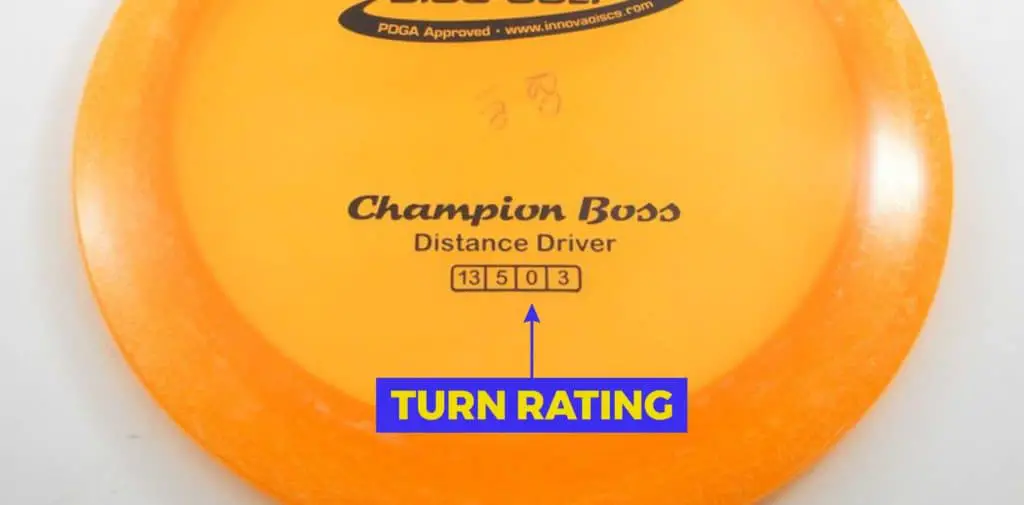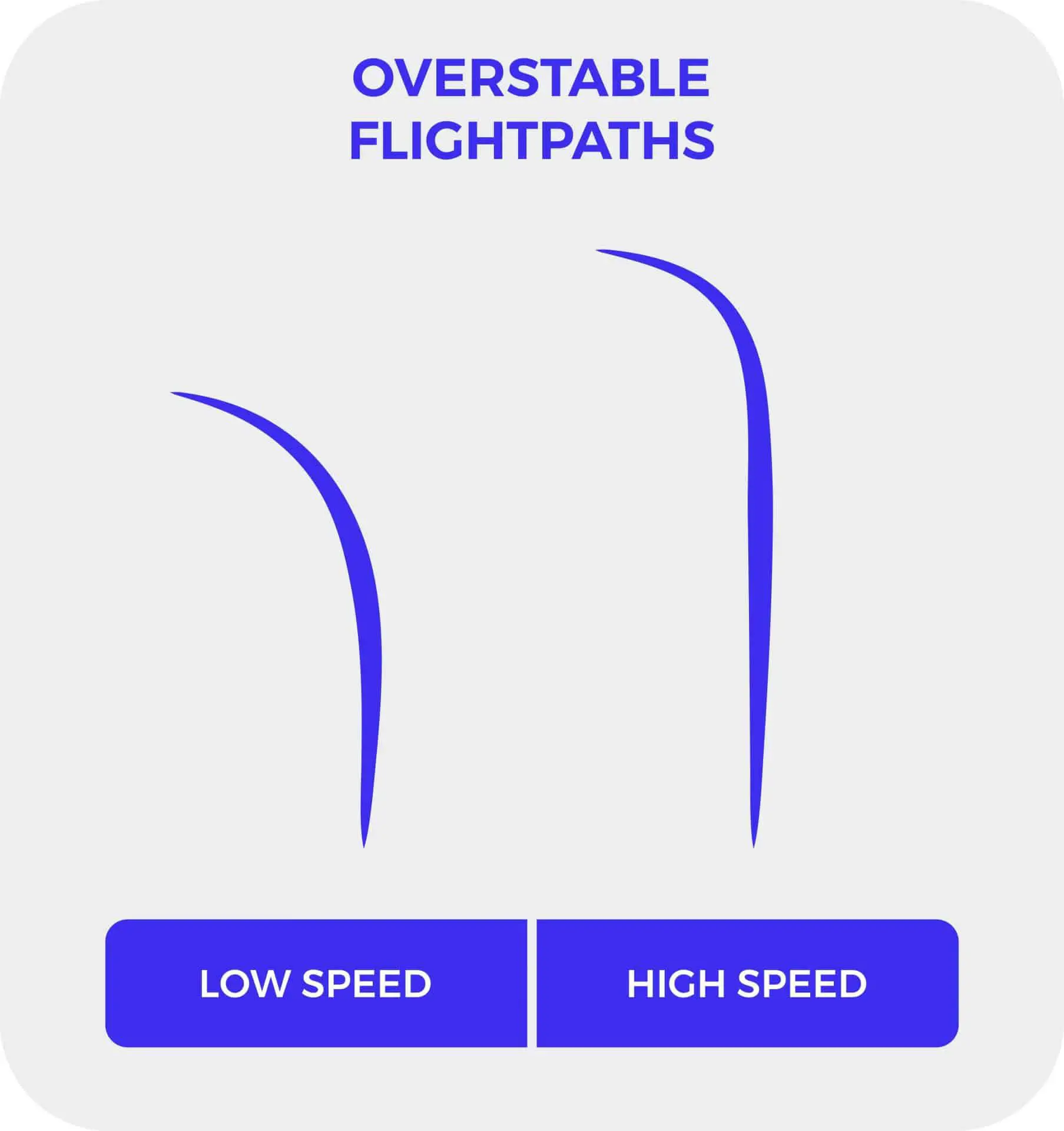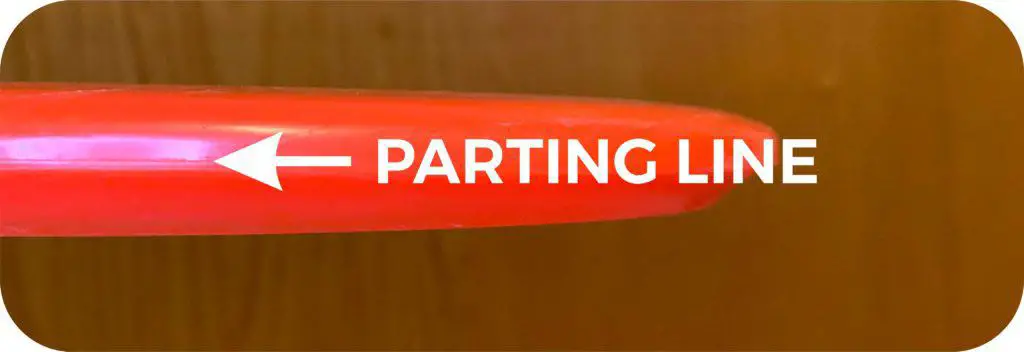When choosing which disc to use, it is important to understand how the disc will fly. See, not all discs fly the same way, even if you throw them exactly the same. There are a bunch of factors that determine a disc’s flight characteristics, but one of the most commonly referred to is a disc’s stability. Knowing a disc’s stability is a huge factor in knowing how the disc will fly.
Two of the most common and sought after stability types are Understable and Overstable. If you’re trying to figure out how to tell if a disc is Overstable or Understable, let’s cover that now:
How to Tell If A Disc Is Overstable or Understable:
One quick way to tell if a disc is Overstable or Understable is to look at its Turn rating. This is typically the third number on the disc. Understable discs are rated -5 to -3, stable discs are rated -2 to -1 and Overstable discs are rated 0 to 1. So the closer the turn rating is to -5, the more Understable it will be, and the closer the turn rating is to 1, the more Overstable it will be.

Different disc stabilities will come in handy for a range of scenarios in your disc golf game and knowing how to choose and throw the discs properly will only benefit you.
But there’s much more to it than just turn rating. You’ll need to have a good understanding of disc stability and how it’s determined to get a better read on your discs.
Power Grip Breakdown
I’ve done a breakdown of all the grips in this guide, and they’re all free to watch. Use the link below to get to all the videos.
What Is Disc Stability?
Disc stability describes how a disc’s physical design affects the way that it flies. It is also commonly associated with high-speed turn because it describes how the disc will turn in the air. High speed turn refers to how the disc will behave while it is moving at high speed, but at the end of the flight, the disc slows down. During the slower part of the flight, low speed fade describes how the disc will behave.


The science behind why a disc moves the way it does is because when the rim of the disc pushes air over its top, which results in less air pressure above the disc than below it. The increased pressure under the disc creates lift, which is why the disc flies. If the disc is angled with the nose upward, it pushes air down at the back, which result in air pushing the disc up at the front. The lift pushes the nose, or the front, of the disc up.
If you just threw a disc without any spin, this would cause the front to lift up, flipping the disc backwards. When you throw a disc, it spins which creates angular momentum. The spin spreads the lift effect around the disc giving it more stability. The faster the disc is spinning, the more stable it is.
An understable disc is designed to push more air over it rather than under it. An understable disc thrown spinning clockwise will have force pushing down the right side causing the disc to turn to the right. An overstable disc is designed so that there is more air passing under it than over it and the force pushes up the right side causing the disc to turn to the left.
These effects change depending on the direction the disc is spinning. For example, if you are are throwing left-hand backhand or right-hand forehand an understable disc will turn left and an overstable disc will turn right.
What Affects a Disc’s Stability?
Disc stability is influenced by the shape of the disc and how weight is distributed across it. A lot of these factors can be a result of the plastic choice. The shape of the different parts of the disc can also have a significant impact.
Parting line height is thought to be the biggest factor in disc stability. The parting line is the line in the plastic along where the two parts of the mold meet during manufacturing. The line height is a reflection of how the plastic reacts to the cooling process.

Plastics tend to shrink when they cool, and some plastics shrink more than others. That is why the same disc design will behave differently depending on what plastic it is made of. Discs with a higher parting line will tend to be more overstable and discs with lower parting lines tend to be more overstable.
The type of plastic can affect stability in other ways. More durable types of plastics will tend to be more overstable. Less durable plastics tend to be more understable. Plastic stiffness can also affect stability. Stiffer plastics tend to be more overstable and more flexible plastics tend to fly more stable than the stiffer blends.
Dome height may also play a role in disc stability. Flatter discs tend to be more overstable and discs with a higher dome tend to be stable.
However, dome height may only appear to affect stability by increasing or diminishing the impact of stability on the disc. This is because a flatter disc holds the angle of release longer through its flight and has less glide while discs with a higher dome have more glide so will end up turning more.
The dome height will also affect how blunt the disc is, which can also affect stability. Flat discs tend to have noses that are blunter, while discs with a higher dome tend to have noses that are more rounded. Blunter noses tend to be more overstable.
Similarly, wing shape can affect stability. A more concave bend in the wing shape will make the disc fly more overstable, while flatter wing shapes will be less stable.
Some discs are beaded. A bead is a small added rim of plastic at the bottom of the disc. Beaded discs tend to be more stable to overstable. Beading is most common on putters.
Disc stability can also change over time. As the plastic ages and dries out, its stability may change. Also, if you use it a lot, all the dings and wear on the disc can affect stability.
In Depth: How to Tell If a Disc is Overstable or Understable
To tell if a disc is overstable or understable you could analyze its design, checking parting line height and dome shape, but there are easier ways.
The first way is to check the disc’s turn rating. Most discs have a series of numbers on them know as their flight ratings. Stability is indicated by the turn rating, which is typically the third number. The rating system goes from -5 to 1. Understable discs are rated -5 to -3, stable discs are rated -2 to -1 and overstable discs are rated 0 to 1.
The rating system may vary for different manufacturers and you may find that discs do not always fly how you would expect based on their turn rating. On their website, Innova Discs explains that flight ratings are not meant to predict the exact flight pattern of a disc, but to compare between different models because there are other factors that will influence a disc’s flight, such as the type of plastic.

Like I mentioned above, the turn rating will give you a quick idea of the disc’s stability, but for a more accurate measure, combine high-speed turn and low-speed fade. The disc will also turn during the slower part of the flight known as fade. Add the turn and fade ratings together. If it is between -1 and -5, it is understable with -5 being the most understable. If it is 0, the disc is stable. If it is 1 to 5 it is overstable with 5 being the most overstable.
The most effective way to tell if a disc is overstable or understable is to throw it. Try throwing the disc backhand and aiming straight. For right-handed players, an understable disc will turn to the right and an overstable disc will turn to the left. A stable disc will go straight. For left-handed players, they will go the opposite directions. You need to throw the disc correctly for this to work because different aspects of your technique could cause the disc to turn, such as if you don’t throw it at the correct speed.
When Would You Use an Understable or an Overstable Disc
Understable and overstable discs come in handy in a range of scenarios. Part of it is about choosing the right disc for the type of throw and the situation, but part of it is also choosing the right disc for your abilities.
Understable Discs
An understable disc is helpful if you are right-handed throwing backhand and want the disc to turn to the right or the inverse for left-handed players. This can be helpful for getting around obstacles or following a curve in the course. Even though the disc turns right in its flight, it will still fade back to the left. If you are trying to throw anhyzer, a shot that is meant to go to the right, using an understable disc will help with the movement to the right.
Understable discs are great for beginners because they are easier to control. They do not need to be thrown as fast as overstable discs to have their intended flight characteristics. Because of this, they may allow beginners to get the most distance that they can achieve with their abilities. Understable discs are not good in strong winds. They can be more affected by the wind and less predictable.
Overstable Discs
An overstable disc will be helpful if you want to turn left when you are throwing right-handed backhand or right if you are throwing left-handed. This can also be helpful for getting around obstacles or following a curve in the course. It can also help with hyzer throws where you are trying to get the disc to turn.
Overstable discs are better for experienced players because they need to be thrown at a higher speed to follow their intended flight path. Advanced players often use overstable drivers because they can travel farther. Overstable discs are good for working against the wind. They are also good for skip shots.
Conclusion
Now that you have a better understanding of disc stability and how a disc flies, try playing around with different discs and see if you can gauge the stability based on its flight. You can also experiment with combining different throws with different disc stabilities to see what flight patterns you can get. Just remember to choose a disc that will benefit your disc golf game and don’t choose a disc based on what other players throw.
